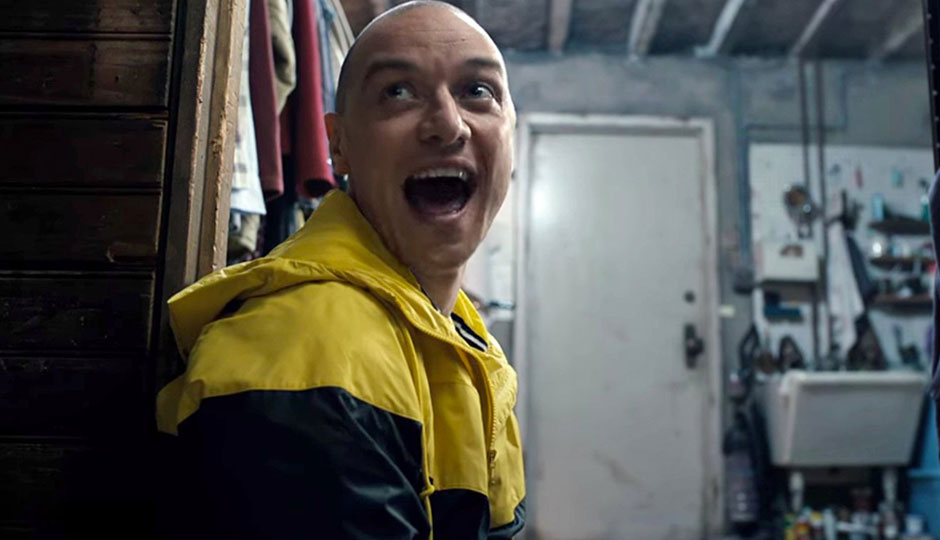We Need to Talk About the End of M. Night Shyamalan’s Split

James McAvoy as Kevin in “Split” | Image: Universal
Here’s a twist for you: M. Night Shyamalan is back.
The director’s Split made an estimated $40 million this weekend. Critics liked it, too. And the movie is his buzziest film since The Sixth Sense.
I saw it at a packed Cherry Hill theater Friday night, with teenagers screaming and laughing at what was my favorite M. Night Shyamalan movie since Unbreakable. James McAvoy is tremendous as a man shifting through multiple personalities. Even my issues with the movie — there’s perhaps a bit of gratuitous sexualization, and the movie’s treatment of dissociative identity disorder will probably meet some resistance — are mostly stylistic issues. The only thing I really disliked on my first viewing of the film was the awful fake TV news copy during two segments, which sounded nothing like actual news reports. And, let’s be fair, I’m probably the only person who cares about that.
As with most of M. Night Shyamalan’s movies, Split also showcases Philadelphia at multiple opportunities. There are locations all over the city, and McAvoy’s character lives in a place where there are multiple Phillies and Eagles stickers on the walls. It’s like Shyamalan is saying: “Sure, this guy’s a maniac — but don’t forget he’s also an Eagles fan!”
The movie is a critical and commercial success (the film’s budget was reportedly just $10 million). But, as with any Shyamalan movie, it’s the ending that really makes it. And the ending of Split is the biggest twist M. Night Shyamalan has ever pulled off. I’d like to discuss it, but you absolutely shouldn’t have this movie spoiled for you. So venture on — but only if you’ve seen the film.

Seriously, do not read on unless you’ve seen Split.
Split is the story of Kevin Wendell Crumb (James McAvoy), a man with 23 individual personalities in one body. He kidnaps three girls from the King of Prussia Mall parking lot — right in front of Cantina Laredo, per my friend David Onda at Comcast — in an attempt to use the girls as “sacred food” for his transformation into a 24th, superhuman personality, known as The Beast. At the end of the film, he kills two of the girls but spares Anya Taylor-Joy’s Casey Cooke because he learns she, too, has been abused as a child.
Then comes the last scene: One of the aforementioned news reports talks about the discovery of Casey at the Philadelphia Zoo, where Kevin has been hiding the girls. It also says Kevin has escaped after surviving two shotgun blasts, and police sources are calling him “The Horde.”
A patron at the diner says it reminds her of another notorious Philadelphia criminal, but she can’t remember what they called him. And a maintenance worker leans forward and says, “Mr. Glass.” It’s David Dunn, Bruce Willis’ character from Unbreakable. In that film, Dunn survives a train crash, and comic book shop owner who uses a wheelchair (Samuel L. Jackson) convinces him he’s indestructible — a literal super hero. But it turns out Jackson’s character was the one who created a series of disasters for Willis’ character to survive. When Willis’ character realizes this, Jackson’s character then says: “They called me Mr. Glass.” Split and Unbreakable take place in the same world.
Unbreakable was generally well-received upon release in 2000, but it has undergone a critical surge as of late. New York’s Vulture — an influential entertainment website despite occasionally employing me to make animated GIFs — named it the best superhero movie since 1998 (which is basically ever, unless you really like Tim Burton’s Batman). “This is what the future of superhero flicks should look like,” the site’s Abraham Riesman writes. “As wonderful as superhero comics are… more filmmakers need to take M. Night Shyamalan’s cue (there’s a phrase you don’t see very often) and liberate the superhero from the shackles of licensing constraints and fan-pandering. Before the caped-crusader boom kicked in, Shyamalan crafted a movie that’s quiet, sad, delicate, intelligent, and yet unmistakably about a superhero.”
I think Shyamalan’s ending works in a matter of ways. At its most base level, it’s a cute little callback to a movie he made roughly 16 years ago. It’s a parody of M. Night Shyamalan’s use of twists in movies (there’s almost no way to predict it, unless you noticed Shyamalan re-used a portion of the Unbreakable score toward the end). It’s also a parody of the “credit cookie” common in superhero films nowadays — it actually comes after the end title (further extending his deconstruction of the superhero genre he first did in Unbreakable).
But the coolest explanation of the film’s ending is this: Split was actually a super-villain origin story. The ending leaves open the possibility of a third film, where the Unbreakable Man battles The Horde. M. Night Shyamalan has created a Philadelphia Superhero Cinematic Universe. That even explains the crappy news reports, because journalists in comics books are terrible (J. Jonah Jameson somehow can’t figure out Spider-man is Peter Parker, and I don’t think Clark Kent has filed a story in decades).
Philly has a history in the superhero comic book world — I particularly liked Duane Swierczynski’s series with the Punisher in Philly, and Venom’s run in Philadelphia was decent enough — but this is something else. We could have an actual, real life superhero movie set in Philly.
The success of Split means there’s a greater chance of it happening, too. Shyamalan told reporters who saw the film that he was open to a third one in the series. M. Night Shyamalan has made some critically-panned movies, but if he gives us superheroes battling on the streets of Philadelphia all will be forgiven. I am giddy at the prospect.


